IDEX Online Research: U.S. Specialty Jewelers’ Census Shows Decline (Full Analysis)
February 03, 10
For the past four decades, the American retailing industry has been consolidating. While there may be more stores, there are far fewer corporate firms in the retail sector. For the most part, retail sectors in the U.S. are dominated by a duopoly or triopoly of corporate owners – two or three huge merchants own and operate most of the stores, often under a variety of brand names.
There were several events which contributed to the decrease of small retailers and the dramatic increase of large merchants, including the following:
· Sometime in the 1960s, the “Blue Laws” were struck down; these laws had restricted Sunday retail store openings. Thus, merchants now had to staff their stores seven days a week, something that was not possible for most mom-and-pop merchants.
· Retail price maintenance statutes were ruled unconstitutional at about the same time. Thus, large high-volume merchants could undercut the prices that small retailers charged, driving traffic to those high-volume stores and putting low-volume mom-and-pop retailers out of business
· Shopping mall developers made deals with national chain merchants, effectively eliminating local retailers from entering new high-traffic malls.
· Overseas sourcing of low-cost merchandise was a competitive differential available only to large, well-capitalized merchants.
Against this background, it is no wonder that most sectors in the retail category have undergone consolidation. In the home center / hardware sector, Lowe’s and Home Depot own the industry. Independent office supply merchants are gone; replaced by Staples, Office Depot and OfficeMax. The same trends have affected the pet supply industry, consumer electronics, grocery stores and even mass market retailers. Mom-and-pop merchants simply don’t exist in most retail sectors anymore.
Jewelry Industry Remains Unconsolidated
The jewelry industry has remained relatively unconsolidated. Until recently, the total number of doors in the industry was relatively static at just over 26,000; there were over 23,000 different corporate owners. For most of the 2000s, when a mom-and-pop jeweler closed, a chain store opened. Despite this tit-for-tat store shift toward chains, the top five retail specialty jewelers held a paltry aggregate market share of about 12 percent at the end of 2008.
What is different about the jewelry industry?
Jewelry is an infrequently purchased big-ticket item generally purchased on credit. Consumers need sales associates to educate them; the credit process is labor-intensive. There have been dozens of attempts to open big-box high-volume jewelry stores, with only limited success. Thus, like florists, cobblers, wine shops and a handful of other retail sectors where customer service is a high priority, it is unlikely that the jewelry industry will experience consolidation on the scale of other retail sectors.
Jewelry Doors & Firms Declining
New census data from the Labor Department, coupled with the Jewelers Board of Trade information (JBT), shows that the jewelry industry is shrinking in number of stores as well as number of jewelry firms. Further, the industry is losing market share to other retail sectors – multi-line merchants, discounters, mass marketers, and other specialty retailers. In the early 1970s, specialty jewelers held about 73 percent of the market share for U.S. jewelry sales; this has dropped to about 47 percent today.
Despite the recessionary environment over the past two years, the number of jewelry firms fell by less than 2 percent in 2009 – nearly in line with the decade’s average decline of 1.7 percent. However, the number of jewelry doors has fallen sharply in the past two years, reflecting the demise of chain jewelers such as Friedman’s and Whitehall.
Here is a tally of census data from the JBT compared to the Labor Department. JBT census counts firms (Zale is counted as “1”) while the Labor Department counts doors (each Zale store is counted separately.) Please note that JBT census data shows more firms than BLS doors through 2000; this data is prior to a major re-class of firms by JBT.
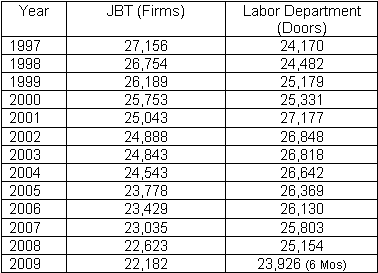 Source: JBT & BLS |
The biggest surprise is that consolidation among jewelry retailers hasn’t been accelerated by the recessionary environment. Our forecast: any jeweler who has held on this long is likely to remain in business for the near term. Thus, we don’t look for any dramatic acceleration in jewelry retailing failures in 2010 or 2011.
The graph below compares the number of doors to the number of firms from 2001 through 2009 (door census data is available only through the second quarter of 2009) based on the data from the table above.
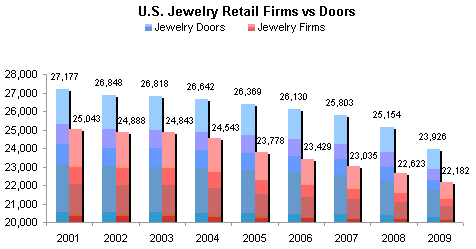 Source: JBT & BLS |
Specialty Jewelers’ Financial Health Relatively Stable
Jewelry suppliers made fewer claims for unpaid bills against jewelry retailers in 2009 when compared to the prior year, but the average amount of those unpaid claims rose, according to data from the JBT. The table below compares the number of vendor claims against retail jewelers as well as the average claim for the 2009 period versus 2008.
 |
Despite a decline in the number of bad debt claims, the JBT reduced the credit ratings of more jewelers versus those who earned a higher credit rating for the year. However, the ratio of credit rating increases versus decreases rose very modestly in 2009 to 85 percent compared with 84 percent for the prior year; this suggests that retail jewelers’ credit quality appears to have increased very slightly. The table below illustrates the number of credit rating changes for 2009 versus 2008.
 |
Regional Jewelry Firm Openings & Closures Vary Widely
If you want to operate a jewelry store in a geographic area where commerce is stable and there is little retailing turnover, you should choose between the Southeast or the Northwest. While the South Central region has the fewest jewelry failures, it also has the most jewelry openings. This indicates that its stability is not a well-kept secret.
The following table summarizes the number of jewelers by geographic region as well as the number of jewelry failures during 2009 and the number of new jewelers who opened stores last year. In addition, the total number of new businesses – retailers, wholesalers and manufacturers – is shown by region in 2009.
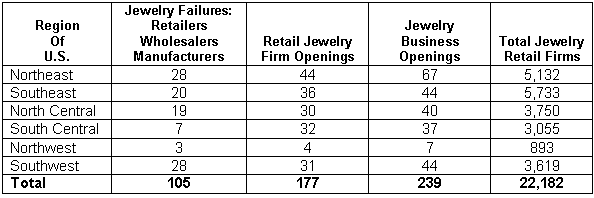 |
The failure rate as a percentage of total jewelry firms by region is shown on the graph below. It is clear that there are fewer jewelry failures in the Southeast, South Central, and the Northwest.
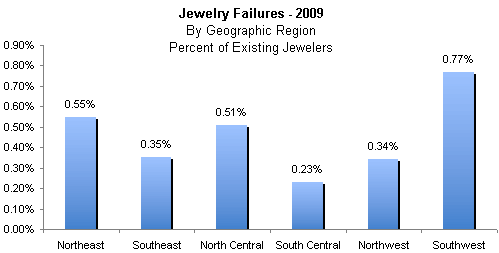 Source: JBT & Census Bureau |
The new jewelry store opening rate by region is shown on the graph below. Once again, the Southeast and the Northwest show the least activity; perhaps because there are few store closings which indicates that the regional economy is relatively stable.
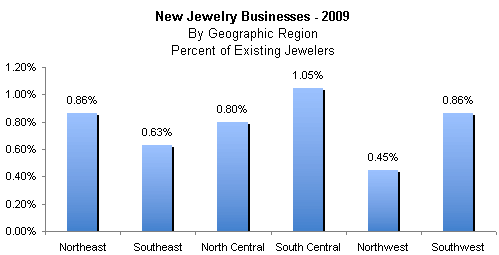 Source: JBT |
Business Discontinuances Rise
The JBT also publishes a table called Business Discontinuances Summary. It includes business discontinuances of jewelry retailers, wholesalers, and manufacturers. It also includes some jewelry businesses that simply fade into the dark of the night. It does not correlate exactly to the other figures in the JBT report for a variety of reasons, but it does offer a look at the magnitude of change by type of business discontinuances during the year. This table is shown below – with the caveat that the numbers do not “foot and cross” with other numbers shown in this report. The information in the table is useful to determine “directional” changes and “order of magnitude.”
 |
A Silver Lining to Consolidation
With every challenge comes an opportunity. Based on data developed by IDEX Online Research, the average sales per store for specialty retailers has fallen only very modestly since 2007, after rising for several years. The slight decline in per-store sales is no surprise in the current recessionary environment.
However, this trend is likely to reverse in 2010. As jewelry demand growth reaccelerates in the post-recession environment, there will be fewer specialty jewelers competing for a larger market. Sales per store should rise, which should help generate economic operating efficiencies and produce greater profits for those jewelry merchants who have survived.
Outlook for 2010
If you’re a jeweler and you’ve made it this far, you have a good chance of remaining in business, at least for the near term. There are several tailwinds, including the following:
· Consumers have loosened their purse strings.
· The U.S. economy is on the mend.
· Banks are loaning money.
· Consumers’ wealth factors are rising. The stock market is up, and home prices appear to be headed higher.
· Core jewelry demand is set to grow. Bridal jewelry demand will provide most of the impetus for growth near term.
On the other hand, there are some headwinds, including the following:
· We really aren’t “out of the woods” yet.
· Your credit must be sterling to get a bank loan.
· The economic recovery is still very fragile.
· Your challenge will be to get luxury goods shoppers into your store.
Our prediction: the number of retail jewelry firms will continue to decline at its recent rate – a net loss of about 400 or so firms annually – in 2010. The number of wholesalers will continue to decline at an accelerating rate, and manufacturing in the U.S. will continue to diminish.
The best news: consumers are ready to shake off the burden of the recession and get back into the stores. If you are a jeweler, be ready for them with new goods and a positive attitude.